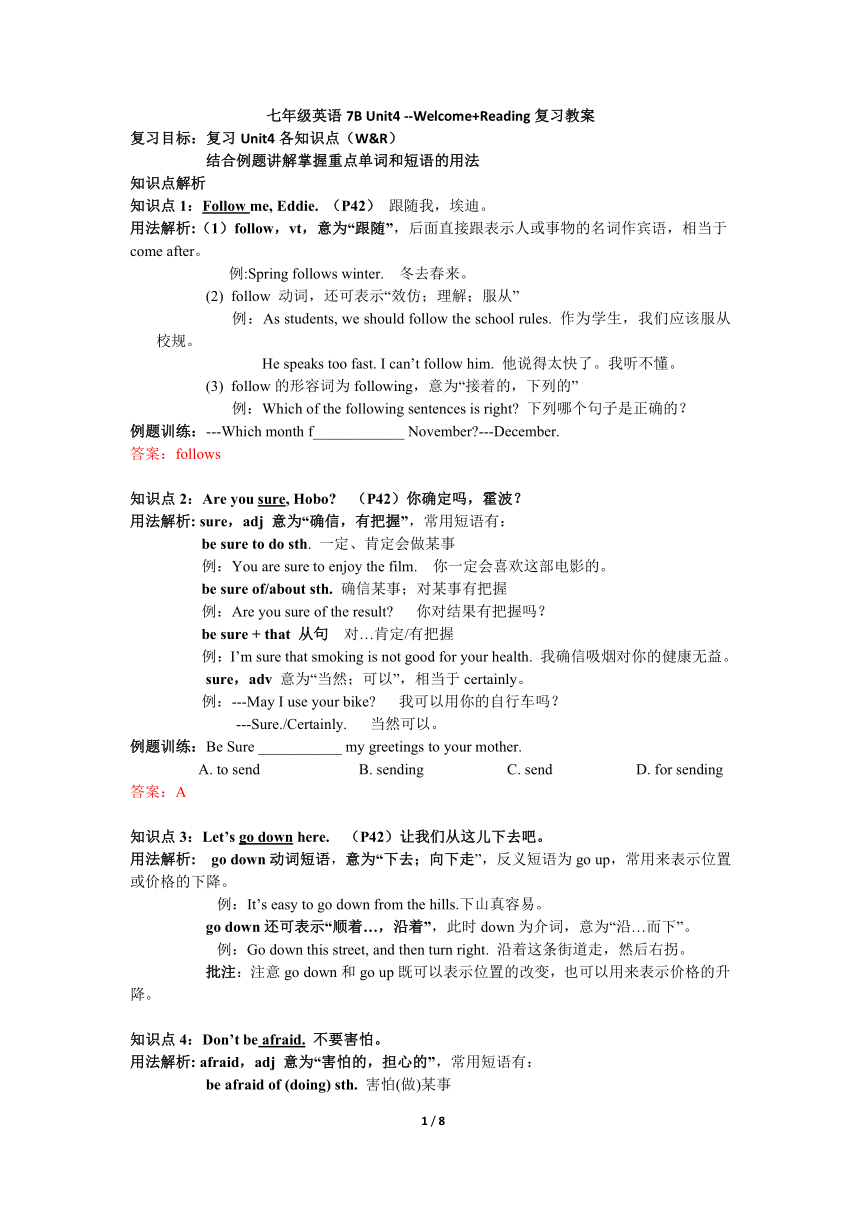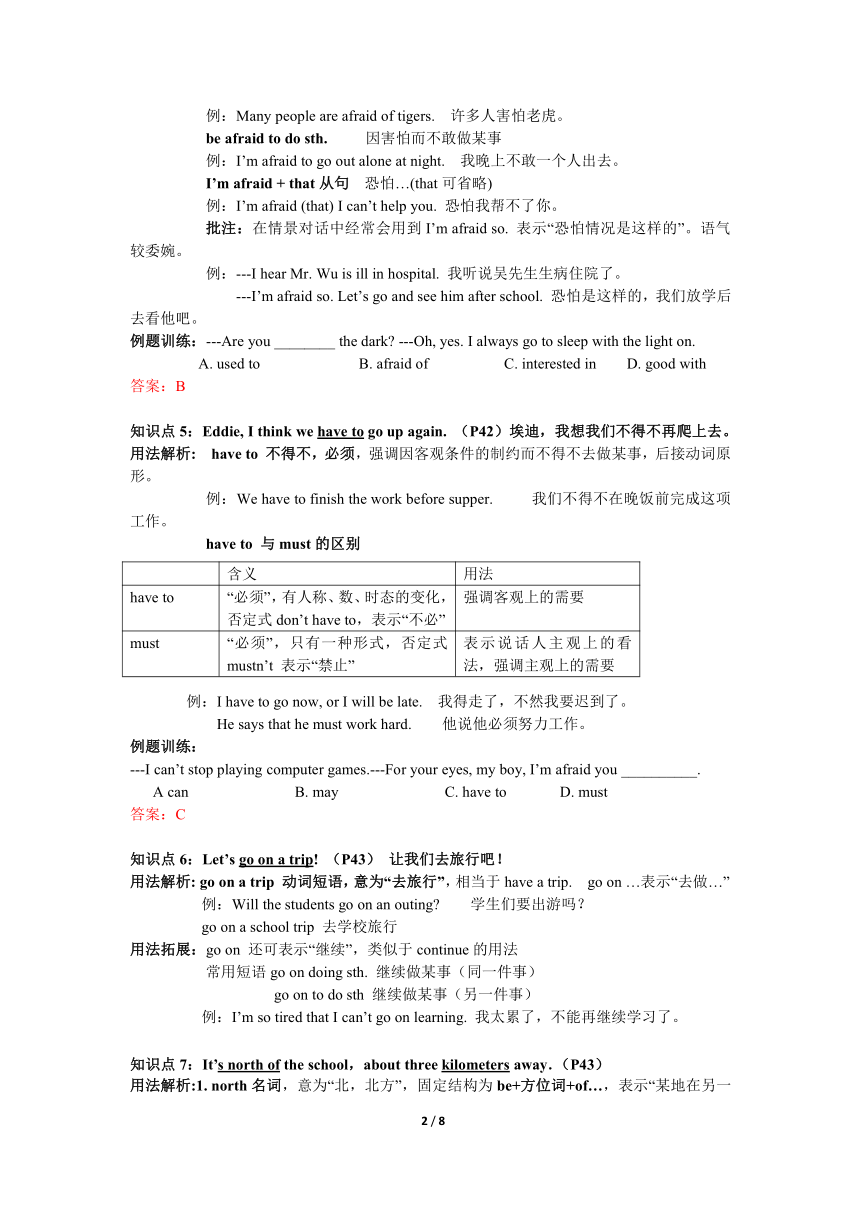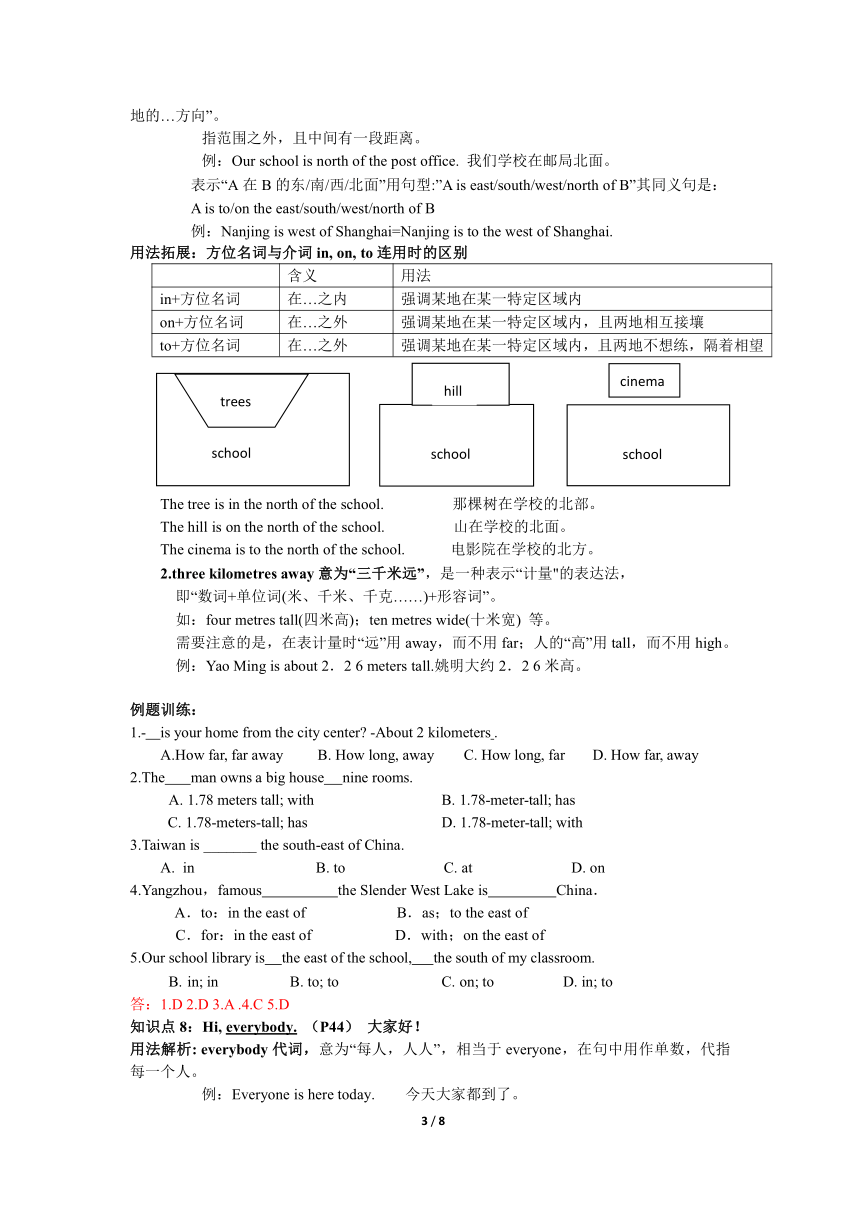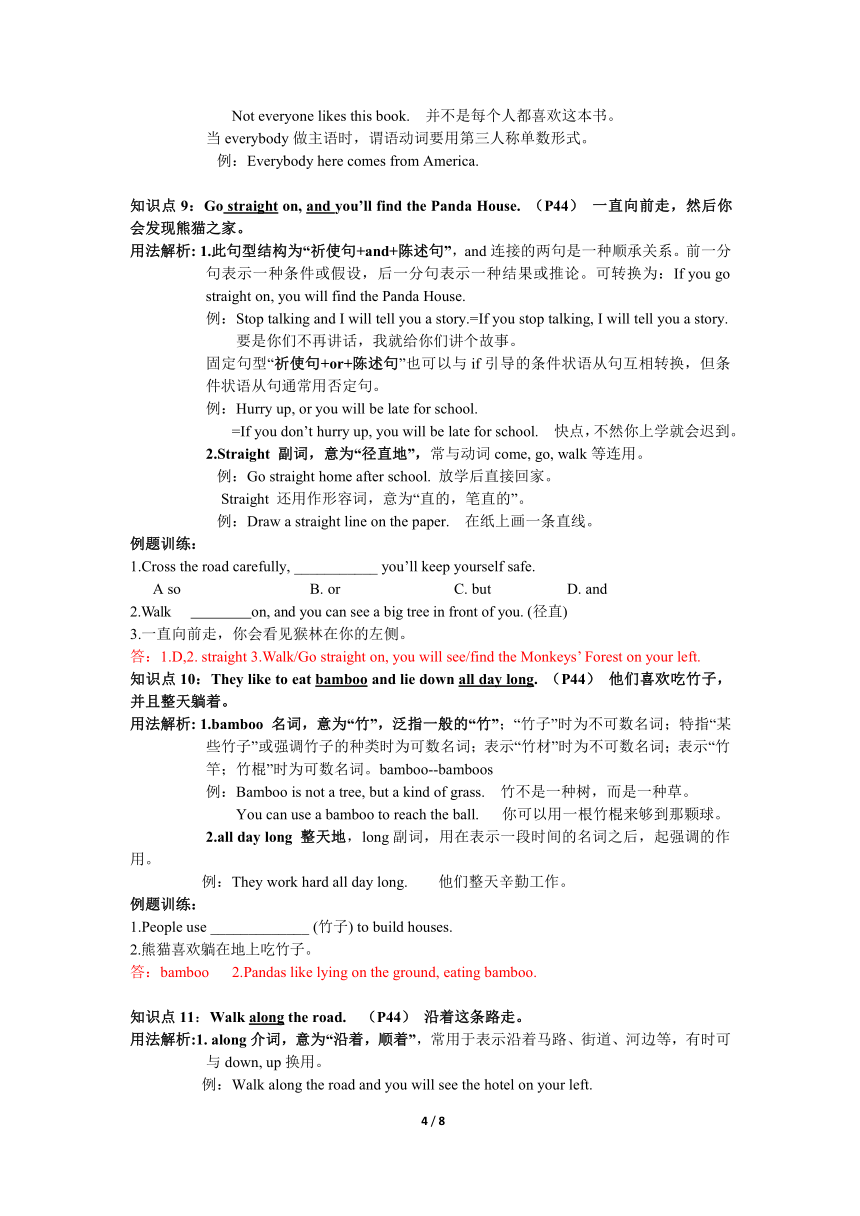Unit 4 Finding your way Welcome+Reading 复习教案
文档属性
| 名称 | Unit 4 Finding your way Welcome+Reading 复习教案 |  | |
| 格式 | zip | ||
| 文件大小 | 38.2KB | ||
| 资源类型 | 教案 | ||
| 版本资源 | 牛津译林版 | ||
| 科目 | 英语 | ||
| 更新时间 | 2020-06-10 21:09:27 | ||
图片预览




文档简介
七年级英语7B
Unit4
--Welcome+Reading复习教案
复习目标:复习Unit4各知识点(W&R)
结合例题讲解掌握重点单词和短语的用法
知识点解析
知识点1:Follow
me,
Eddie.
(P42)
跟随我,埃迪。
用法解析:(1)follow,vt,意为“跟随”,后面直接跟表示人或事物的名词作宾语,相当于come
after。
例:Spring
follows
winter.
冬去春来。
follow
动词,还可表示“效仿;理解;服从”
例:As
students,
we
should
follow
the
school
rules.
作为学生,我们应该服从校规。
He
speaks
too
fast.
I
can’t
follow
him.
他说得太快了。我听不懂。
follow的形容词为following,意为“接着的,下列的”
例:Which
of
the
following
sentences
is
right?
下列哪个句子是正确的?
例题训练:---Which
month
f____________
November?---December.
答案:follows
知识点2:Are
you
sure,
Hobo?
(P42)你确定吗,霍波?
用法解析:
sure,adj
意为“确信,有把握”,常用短语有:
be
sure
to
do
sth.
一定、肯定会做某事
例:You
are
sure
to
enjoy
the
film.
你一定会喜欢这部电影的。
be
sure
of/about
sth.
确信某事;对某事有把握
例:Are
you
sure
of
the
result?
你对结果有把握吗?
be
sure
+
that
从句
对…肯定/有把握
例:I’m
sure
that
smoking
is
not
good
for
your
health.
我确信吸烟对你的健康无益。
sure,adv
意为“当然;可以”,相当于certainly。
例:---May
I
use
your
bike?
我可以用你的自行车吗?
---Sure./Certainly.
当然可以。
例题训练:Be
Sure
___________
my
greetings
to
your
mother.
A.
to
send
B.
sending
C.
send
D.
for
sending
答案:A
知识点3:Let’s
go
down
here.
(P42)让我们从这儿下去吧。
用法解析:
go
down动词短语,意为“下去;向下走”,反义短语为go
up,常用来表示位置或价格的下降。
例:It’s
easy
to
go
down
from
the
hills.下山真容易。
go
down还可表示“顺着…,沿着”,此时down为介词,意为“沿…而下”。
例:Go
down
this
street,
and
then
turn
right.
沿着这条街道走,然后右拐。
批注:注意go
down和go
up既可以表示位置的改变,也可以用来表示价格的升降。
知识点4:Don’t
be
afraid.
不要害怕。
用法解析:
afraid,adj
意为“害怕的,担心的”,常用短语有:
be
afraid
of
(doing)
sth.
害怕(做)某事
例:Many
people
are
afraid
of
tigers.
许多人害怕老虎。
be
afraid
to
do
sth.
因害怕而不敢做某事
例:I’m
afraid
to
go
out
alone
at
night.
我晚上不敢一个人出去。
I’m
afraid
+
that从句
恐怕…(that可省略)
例:I’m
afraid
(that)
I
can’t
help
you.
恐怕我帮不了你。
批注:在情景对话中经常会用到I’m
afraid
so.
表示“恐怕情况是这样的”。语气较委婉。
例:---I
hear
Mr.
Wu
is
ill
in
hospital.
我听说吴先生生病住院了。
---I’m
afraid
so.
Let’s
go
and
see
him
after
school.
恐怕是这样的,我们放学后去看他吧。
例题训练:---Are
you
________
the
dark?
---Oh,
yes.
I
always
go
to
sleep
with
the
light
on.
A.
used
to
B.
afraid
of
C.
interested
in
D.
good
with
答案:B
知识点5:Eddie,
I
think
we
have
to
go
up
again.
(P42)埃迪,我想我们不得不再爬上去。
用法解析:
have
to
不得不,必须,强调因客观条件的制约而不得不去做某事,后接动词原形。
例:We
have
to
finish
the
work
before
supper.
我们不得不在晚饭前完成这项工作。
have
to
与must的区别
含义
用法
have
to
“必须”,有人称、数、时态的变化,否定式don’t
have
to,表示“不必”
强调客观上的需要
must
“必须”,只有一种形式,否定式mustn’t
表示“禁止”
表示说话人主观上的看法,强调主观上的需要
例:I
have
to
go
now,
or
I
will
be
late.
我得走了,不然我要迟到了。
He
says
that
he
must
work
hard.
他说他必须努力工作。
例题训练:
---I
can’t
stop
playing
computer
games.---For
your
eyes,
my
boy,
I’m
afraid
you
__________.
A
can
B.
may
C.
have
to
D.
must
答案:C
知识点6:Let’s
go
on
a
trip!
(P43)
让我们去旅行吧!
用法解析:
go
on
a
trip
动词短语,意为“去旅行”,相当于have
a
trip.
go
on
…表示“去做…”
例:Will
the
students
go
on
an
outing?
学生们要出游吗?
go
on
a
school
trip
去学校旅行
用法拓展:go
on
还可表示“继续”,类似于continue的用法
常用短语go
on
doing
sth.
继续做某事(同一件事)
go
on
to
do
sth
继续做某事(另一件事)
例:I’m
so
tired
that
I
can’t
go
on
learning.
我太累了,不能再继续学习了。
知识点7:It’s
north
of
the
school,about
three
kilometers
away.(P43)
用法解析:1.
north名词,意为“北,北方”,固定结构为be+方位词+of…,表示“某地在另一地的…方向”。
指范围之外,且中间有一段距离。
例:Our
school
is
north
of
the
post
office.
我们学校在邮局北面。
表示“A在B的东/南/西/北面”用句型:”A
is
east/south/west/north
of
B”其同义句是:
A
is
to/on
the
east/south/west/north
of
B
例:Nanjing
is
west
of
Shanghai=Nanjing
is
to
the
west
of
Shanghai.
用法拓展:方位名词与介词in,
on,
to连用时的区别
含义
用法
in+方位名词
在…之内
强调某地在某一特定区域内
on+方位名词
在…之外
强调某地在某一特定区域内,且两地相互接壤
to+方位名词
在…之外
强调某地在某一特定区域内,且两地不想练,隔着相望
(
school
trees
school
hill
school
cinema
)
The
tree
is
in
the
north
of
the
school.
那棵树在学校的北部。
The
hill
is
on
the
north
of
the
school.
山在学校的北面。
The
cinema
is
to
the
north
of
the
school.
电影院在学校的北方。
2.three
kilometres
away意为“三千米远”,是一种表示“计量"的表达法,
即“数词+单位词(米、千米、千克……)+形容词”。
如:four
metres
tall(四米高);ten
metres
wide(十米宽)
等。
需要注意的是,在表计量时“远”用away,而不用far;人的“高”用tall,而不用high。
例:Yao
Ming
is
about
2.2
6
meters
tall.姚明大约2.2
6米高。
例题训练:
1.-
is
your
home
from
the
city
center?
-About
2
kilometers
.
A.How
far,
far
away
B.
How
long,
away
C.
How
long,
far
D.
How
far,
away
2.The
man
owns
a
big
house
nine
rooms.
1.78
meters
tall;
with
B.
1.78-meter-tall;
has
C.
1.78-meters-tall;
has
D.
1.78-meter-tall;
with
3.Taiwan
is
_______
the
south-east
of
China.
in
B.
to
C.
at
D.
on
4.Yangzhou,famous
the
Slender
West
Lake
is
China.
A.to:in
the
east
of
B.as;to
the
east
of
C.for:in
the
east
of
D.with;on
the
east
of
5.Our
school
library
is
the
east
of
the
school,
the
south
of
my
classroom.
in;
in
B.
to;
to
C.
on;
to
D.
in;
to
答:1.D
2.D
3.A
.4.C
5.D
知识点8:Hi,
everybody.
(P44)
大家好!
用法解析:
everybody代词,意为“每人,人人”,相当于everyone,在句中用作单数,代指每一个人。
例:Everyone
is
here
today.
今天大家都到了。
Not
everyone
likes
this
book.
并不是每个人都喜欢这本书。
当everybody做主语时,谓语动词要用第三人称单数形式。
例:Everybody
here
comes
from
America.
知识点9:Go
straight
on,
and
you’ll
find
the
Panda
House.
(P44)
一直向前走,然后你会发现熊猫之家。
用法解析:
1.此句型结构为“祈使句+and+陈述句”,and连接的两句是一种顺承关系。前一分句表示一种条件或假设,后一分句表示一种结果或推论。可转换为:If
you
go
straight
on,
you
will
find
the
Panda
House.
例:Stop
talking
and
I
will
tell
you
a
story.=If
you
stop
talking,
I
will
tell
you
a
story.
要是你们不再讲话,我就给你们讲个故事。
固定句型“祈使句+or+陈述句”也可以与if引导的条件状语从句互相转换,但条件状语从句通常用否定句。
例:Hurry
up,
or
you
will
be
late
for
school.
=If
you
don’t
hurry
up,
you
will
be
late
for
school.
快点,不然你上学就会迟到。
2.Straight
副词,意为“径直地”,常与动词come,
go,
walk等连用。
例:Go
straight
home
after
school.
放学后直接回家。
Straight
还用作形容词,意为“直的,笔直的”。
例:Draw
a
straight
line
on
the
paper.
在纸上画一条直线。
例题训练:
1.Cross
the
road
carefully,
___________
you’ll
keep
yourself
safe.
A
so
B.
or
C.
but
D.
and
2.Walk
on,
and
you
can
see
a
big
tree
in
front
of
you.
(径直)
3.一直向前走,你会看见猴林在你的左侧。
答:1.D,2.
straight
3.Walk/Go
straight
on,
you
will
see/find
the
Monkeys’
Forest
on
your
left.
知识点10:They
like
to
eat
bamboo
and
lie
down
all
day
long.
(P44)
他们喜欢吃竹子,并且整天躺着。
用法解析:
1.bamboo
名词,意为“竹”,泛指一般的“竹”;“竹子”时为不可数名词;特指“某些竹子”或强调竹子的种类时为可数名词;表示“竹材”时为不可数名词;表示“竹竿;竹棍”时为可数名词。bamboo--bamboos
例:Bamboo
is
not
a
tree,
but
a
kind
of
grass.
竹不是一种树,而是一种草。
You
can
use
a
bamboo
to
reach
the
ball.
你可以用一根竹棍来够到那颗球。
2.all
day
long
整天地,long副词,用在表示一段时间的名词之后,起强调的作用。
例:They
work
hard
all
day
long.
他们整天辛勤工作。
例题训练:
1.People
use
_____________
(竹子)
to
build
houses.
2.熊猫喜欢躺在地上吃竹子。
答:bamboo
2.Pandas
like
lying
on
the
ground,
eating
bamboo.
知识点11:Walk
along
the
road.
(P44)
沿着这条路走。
用法解析:1.
along介词,意为“沿着,顺着”,常用于表示沿着马路、街道、河边等,有时可与down,
up换用。
例:Walk
along
the
road
and
you
will
see
the
hotel
on
your
left.
沿着这条路走,你会发现宾馆就在你的左侧。
2.road
名词,意为“路,道路”,一般指机动车行走的马路。固定短语:on
the
road
在路上。
例:There
is
a
wide
road
between
the
two
towns.
两镇之间有条宽阔的马路。
road,
street与way的区分
含义
用法
road
路,道路
指可供人或车辆通行的较为广阔、平坦的“公路,马路”,含义较为具体
street
街道
指两侧有房屋或商店等建筑物的城镇内的“街道”
way
路;路线
指到达目的地必须经过的途径,含义较为抽象
例:There
is
much
traffic
on
the
road.
路上车辆很多。
Don’t
play
in
the
street.
不要在街道上玩。
Which
way
do
you
usually
choose
to
go
to
the
town?
你进城一般选哪条路线?
例题训练:
1.My
father
has
a
habit
of
jogging
________the
canal(运河)
for
an
hour
in
the
morning.(邗江区期中16-17)
A.between
B.along
C.over
D.through
答:
B
知识点12:Remember
that
they’re
dangerous.
(P44)记住他们是危险的。
用法解析:
1.remember,vt,意为“记住,记得”,后跟名词、代词、不定式或动名词作宾语。
反义词为forget
(忘记)。
例:Do
you
still
remember
me?
你还记得我吗?
用法辨析:remember
to
do
sth.
与remember
doing
sth.
的区别
remember
to
do
sth.
记得要做某事,强调事情还没做
remember
doing
sth.
记得做过某事,强调事情是以前做过的
例:Remember
to
bring
your
book
here
tomorrow.
记得明天把你的书带过来。
I
remember
seeing
you
before.
我记得以前见过你。
类似的用法:forget
to
do(忘记要做某事)&
forget
doing(忘记做过某事);
stop
to
do(停下来做另一件事)&
stop
doing(停止做某事)等
2.dangerous,adj,意为“危险的”,在句中作定语或表语,反义词为safe(安全的)
例:It’s
dangerous
to
play
with
fire.
玩火是危险的。
dangerous的词型变化及其相应的反义词:
danger
n.
----
safety
dangerous
adj.
---
safe
dangerously
adv.
---
safely
例题训练:
1.Remember
__________
off
the
lights
when
you
leave
the
classroom.
A.
turn
B.
to
turn
C.
turning
D.
turning
2.How
________(danger)
it
is
to
drive
after
drinking.
答:B
dangerous
知识点13:Turn
left,
and
to
the
west
of
the
Lions’
Area,
you’ll
find
the
World
of
Birds.(P44)
用法解析:
turn
left
动词短语,意为“向左拐”,后可接介词into构成短语turn
left/right
into,
表示“向左/右拐进入…”
例:Turn
left
when
you
come
to
the
crossroads.
当你到十字路口时向左拐。
Turn
left
into
a
restaurant.
向左拐进一家餐馆。
例题训练:
right
,
and
you
will
see
giraffes
after
you
the
bridge.
A.To
turn;
along
B.
To
turn;
across
C.
Turn;
over
D.
Turn;
cross
答D
知识点14:Birds
make
beautiful
sounds
when
they
are
sing.(P44)
用法解析:
sound,
n.声音在一般情况下,凡是能听到的声音都可以叫
sound。
例:Birds
always
make
beautiful
sounds.
sound
vi.听起来
sound
like听起来像
例:Your
idea
sounds
great.
用法辨析:与noise,
voice
的用法区别
noise
主要指大声的、令人不愉快的声音,尤指噪音(常用不可数名词)。
例:Stop
making
so
much
noise.
voice
主要指人讲话或唱歌的声音,
指嗓音(是可数名词)。
例:He
has
a
loud
voice.
He
told
me
the
news
in
a
beautiful
voice.
例题训练:
1.-The
song
from
the
robot(机器人)sounds
_.
-
Yes,
it
sounds
a
real
person.
A.well;/
B.
badly;
like
C.
bad;/
D.
great;
like
答:D
知识点14:Monkeys
are
clever
and
funny.
(P44)猴子们是聪明和好笑的。
用法解析:
funny,adj,意为“好笑的,滑稽的”,一般指友善的取笑,可修饰人或物,在句中作定语或表语。
例:I
like
Max
because
I
like
funny
people.
我喜欢马克斯,因为我喜欢有趣的人。
fun,n,意为“有趣的事”,为不可数名词。
have
fun
玩儿的开心,后接doing形式
例:Reading
is
fun.
阅读是件有趣的事。
What
great
fun
we
had
playing
in
the
zoo.
例题训练:---We
will
have
a
school
trip
next
week.
---
.
A.
Have
fun
B.
We
will
C.
I’m
happy
to
hear
it
D.
Don’t
forget
it
答:A
知识点15:They
jump
around
and
make
people
laugh.(P44)
他们跳来跳去并让人们大笑。
用法解析:
1.
laugh动词,意为“笑,大笑”,固定短语laugh
at…嘲笑…
例:His
funny
story
makes
us
laugh.
他讲的滑稽故事使我们开怀大笑。
Don’t
laugh
at
others.
It’s
not
polite.
不要嘲笑别人。这是不礼貌的。
laugh还可作名词,意为“笑”
例:All
of
us
have
a
good
laugh
over
the
joke.
听完这个笑话我们都笑了。
2.make
sb.
do
sth.
使某人做某事。make为使役动词,后接动词原形作宾语补足语。
例:The
strange
noise
makes
him
feel
frightened
at
night.
奇怪的声音使他晚上感到害怕。
批注:make后面跟动词原形,类似的单词还有:一感(feel),二听(hear,
listen
to),三让(let,
make,
have),四看(watch,
see,
notice,
look
at)
例题训练:It
is
impolite
to
_________
those
persons
in
trouble.
A.
laugh
to
B.
laugh
with
C.
laugh
of
D.
laugh
at
答案:D
知识点16:They’re
quite
tall.
(P44)
他们相当的高。
用法解析:
quite,adv,意为“相当,非常”,位于形容词或副词的原级前作状语。
例:The
film
is
quite
interesting.
这部电影很有趣。
类似quite只修饰原级的副词有very,
too,
so等。
批注:很多学生容易混淆quite和quiet的拼写,教师需要提醒学生注意。
知识点17:Cross
the
bridge,
and
you’ll
see
the
elephants.
(P44)
穿过桥,你将会看到大象。
用法解析:
cross动词,意为“穿过,横过”,指从一个平面通过,常用于过路、河、桥、街等。
即:cross
the
road/river/bridge/street
过马路/河/桥/街。
例:Look
left
and
right,
then
cross
the
street.
左右看看,然后再过马路。
cross还可作名词,表示“十字形”
例:You
can
see
a
cross
on
the
door
of
the
doctor’s.
在这个诊所的门上你能看见一个十字形。
cross与across的区别
含义
用法
cross
动词,“穿过”
独自作谓语,直接跟宾语
across
介词,“穿过”
不能独自作谓语,要和表示“走”类的动词walk,
run,
fly,
jump等连用,此时相当于cross。
例:Be
careful
when
you
cross
the
street.=Be
careful
when
you
walk
across
the
street.
你过马路的时候要小心。
例题训练:
1.You
can’t
____________
the
road
now,
because
the
traffic
lights
are
red.
A
keep
B.
across
C.
through
D.
cross
2.过桥你会发现猴林在狮子区域的南面。
3.We
should
be
careful
when
we
walk
(
cross
)the
street.
答案:1.D
2.Cross
the
bridge,
and
you
will
find
the
Moneys’
Forests
(to
the)
south
of
the
Lions’
Area.
3.across
知识点18:There
are
also
birds,aren’t
there?(P46)
用法解析:
此旬是反意疑问句,其基本构成是:陈述句+简短的附加提问?所遵循的基本原则是
“前肯后否,前否后肯"。(不在中考考纲内,做简单了解)
例:The
girl
isn’t
a
student,is
she?
Tom
is
never
late
for
school,
isn't
he
?
He
is
always
the
first
to
school,
isn’t
he?
2
/
8
Unit4
--Welcome+Reading复习教案
复习目标:复习Unit4各知识点(W&R)
结合例题讲解掌握重点单词和短语的用法
知识点解析
知识点1:Follow
me,
Eddie.
(P42)
跟随我,埃迪。
用法解析:(1)follow,vt,意为“跟随”,后面直接跟表示人或事物的名词作宾语,相当于come
after。
例:Spring
follows
winter.
冬去春来。
follow
动词,还可表示“效仿;理解;服从”
例:As
students,
we
should
follow
the
school
rules.
作为学生,我们应该服从校规。
He
speaks
too
fast.
I
can’t
follow
him.
他说得太快了。我听不懂。
follow的形容词为following,意为“接着的,下列的”
例:Which
of
the
following
sentences
is
right?
下列哪个句子是正确的?
例题训练:---Which
month
f____________
November?---December.
答案:follows
知识点2:Are
you
sure,
Hobo?
(P42)你确定吗,霍波?
用法解析:
sure,adj
意为“确信,有把握”,常用短语有:
be
sure
to
do
sth.
一定、肯定会做某事
例:You
are
sure
to
enjoy
the
film.
你一定会喜欢这部电影的。
be
sure
of/about
sth.
确信某事;对某事有把握
例:Are
you
sure
of
the
result?
你对结果有把握吗?
be
sure
+
that
从句
对…肯定/有把握
例:I’m
sure
that
smoking
is
not
good
for
your
health.
我确信吸烟对你的健康无益。
sure,adv
意为“当然;可以”,相当于certainly。
例:---May
I
use
your
bike?
我可以用你的自行车吗?
---Sure./Certainly.
当然可以。
例题训练:Be
Sure
___________
my
greetings
to
your
mother.
A.
to
send
B.
sending
C.
send
D.
for
sending
答案:A
知识点3:Let’s
go
down
here.
(P42)让我们从这儿下去吧。
用法解析:
go
down动词短语,意为“下去;向下走”,反义短语为go
up,常用来表示位置或价格的下降。
例:It’s
easy
to
go
down
from
the
hills.下山真容易。
go
down还可表示“顺着…,沿着”,此时down为介词,意为“沿…而下”。
例:Go
down
this
street,
and
then
turn
right.
沿着这条街道走,然后右拐。
批注:注意go
down和go
up既可以表示位置的改变,也可以用来表示价格的升降。
知识点4:Don’t
be
afraid.
不要害怕。
用法解析:
afraid,adj
意为“害怕的,担心的”,常用短语有:
be
afraid
of
(doing)
sth.
害怕(做)某事
例:Many
people
are
afraid
of
tigers.
许多人害怕老虎。
be
afraid
to
do
sth.
因害怕而不敢做某事
例:I’m
afraid
to
go
out
alone
at
night.
我晚上不敢一个人出去。
I’m
afraid
+
that从句
恐怕…(that可省略)
例:I’m
afraid
(that)
I
can’t
help
you.
恐怕我帮不了你。
批注:在情景对话中经常会用到I’m
afraid
so.
表示“恐怕情况是这样的”。语气较委婉。
例:---I
hear
Mr.
Wu
is
ill
in
hospital.
我听说吴先生生病住院了。
---I’m
afraid
so.
Let’s
go
and
see
him
after
school.
恐怕是这样的,我们放学后去看他吧。
例题训练:---Are
you
________
the
dark?
---Oh,
yes.
I
always
go
to
sleep
with
the
light
on.
A.
used
to
B.
afraid
of
C.
interested
in
D.
good
with
答案:B
知识点5:Eddie,
I
think
we
have
to
go
up
again.
(P42)埃迪,我想我们不得不再爬上去。
用法解析:
have
to
不得不,必须,强调因客观条件的制约而不得不去做某事,后接动词原形。
例:We
have
to
finish
the
work
before
supper.
我们不得不在晚饭前完成这项工作。
have
to
与must的区别
含义
用法
have
to
“必须”,有人称、数、时态的变化,否定式don’t
have
to,表示“不必”
强调客观上的需要
must
“必须”,只有一种形式,否定式mustn’t
表示“禁止”
表示说话人主观上的看法,强调主观上的需要
例:I
have
to
go
now,
or
I
will
be
late.
我得走了,不然我要迟到了。
He
says
that
he
must
work
hard.
他说他必须努力工作。
例题训练:
---I
can’t
stop
playing
computer
games.---For
your
eyes,
my
boy,
I’m
afraid
you
__________.
A
can
B.
may
C.
have
to
D.
must
答案:C
知识点6:Let’s
go
on
a
trip!
(P43)
让我们去旅行吧!
用法解析:
go
on
a
trip
动词短语,意为“去旅行”,相当于have
a
trip.
go
on
…表示“去做…”
例:Will
the
students
go
on
an
outing?
学生们要出游吗?
go
on
a
school
trip
去学校旅行
用法拓展:go
on
还可表示“继续”,类似于continue的用法
常用短语go
on
doing
sth.
继续做某事(同一件事)
go
on
to
do
sth
继续做某事(另一件事)
例:I’m
so
tired
that
I
can’t
go
on
learning.
我太累了,不能再继续学习了。
知识点7:It’s
north
of
the
school,about
three
kilometers
away.(P43)
用法解析:1.
north名词,意为“北,北方”,固定结构为be+方位词+of…,表示“某地在另一地的…方向”。
指范围之外,且中间有一段距离。
例:Our
school
is
north
of
the
post
office.
我们学校在邮局北面。
表示“A在B的东/南/西/北面”用句型:”A
is
east/south/west/north
of
B”其同义句是:
A
is
to/on
the
east/south/west/north
of
B
例:Nanjing
is
west
of
Shanghai=Nanjing
is
to
the
west
of
Shanghai.
用法拓展:方位名词与介词in,
on,
to连用时的区别
含义
用法
in+方位名词
在…之内
强调某地在某一特定区域内
on+方位名词
在…之外
强调某地在某一特定区域内,且两地相互接壤
to+方位名词
在…之外
强调某地在某一特定区域内,且两地不想练,隔着相望
(
school
trees
school
hill
school
cinema
)
The
tree
is
in
the
north
of
the
school.
那棵树在学校的北部。
The
hill
is
on
the
north
of
the
school.
山在学校的北面。
The
cinema
is
to
the
north
of
the
school.
电影院在学校的北方。
2.three
kilometres
away意为“三千米远”,是一种表示“计量"的表达法,
即“数词+单位词(米、千米、千克……)+形容词”。
如:four
metres
tall(四米高);ten
metres
wide(十米宽)
等。
需要注意的是,在表计量时“远”用away,而不用far;人的“高”用tall,而不用high。
例:Yao
Ming
is
about
2.2
6
meters
tall.姚明大约2.2
6米高。
例题训练:
1.-
is
your
home
from
the
city
center?
-About
2
kilometers
.
A.How
far,
far
away
B.
How
long,
away
C.
How
long,
far
D.
How
far,
away
2.The
man
owns
a
big
house
nine
rooms.
1.78
meters
tall;
with
B.
1.78-meter-tall;
has
C.
1.78-meters-tall;
has
D.
1.78-meter-tall;
with
3.Taiwan
is
_______
the
south-east
of
China.
in
B.
to
C.
at
D.
on
4.Yangzhou,famous
the
Slender
West
Lake
is
China.
A.to:in
the
east
of
B.as;to
the
east
of
C.for:in
the
east
of
D.with;on
the
east
of
5.Our
school
library
is
the
east
of
the
school,
the
south
of
my
classroom.
in;
in
B.
to;
to
C.
on;
to
D.
in;
to
答:1.D
2.D
3.A
.4.C
5.D
知识点8:Hi,
everybody.
(P44)
大家好!
用法解析:
everybody代词,意为“每人,人人”,相当于everyone,在句中用作单数,代指每一个人。
例:Everyone
is
here
today.
今天大家都到了。
Not
everyone
likes
this
book.
并不是每个人都喜欢这本书。
当everybody做主语时,谓语动词要用第三人称单数形式。
例:Everybody
here
comes
from
America.
知识点9:Go
straight
on,
and
you’ll
find
the
Panda
House.
(P44)
一直向前走,然后你会发现熊猫之家。
用法解析:
1.此句型结构为“祈使句+and+陈述句”,and连接的两句是一种顺承关系。前一分句表示一种条件或假设,后一分句表示一种结果或推论。可转换为:If
you
go
straight
on,
you
will
find
the
Panda
House.
例:Stop
talking
and
I
will
tell
you
a
story.=If
you
stop
talking,
I
will
tell
you
a
story.
要是你们不再讲话,我就给你们讲个故事。
固定句型“祈使句+or+陈述句”也可以与if引导的条件状语从句互相转换,但条件状语从句通常用否定句。
例:Hurry
up,
or
you
will
be
late
for
school.
=If
you
don’t
hurry
up,
you
will
be
late
for
school.
快点,不然你上学就会迟到。
2.Straight
副词,意为“径直地”,常与动词come,
go,
walk等连用。
例:Go
straight
home
after
school.
放学后直接回家。
Straight
还用作形容词,意为“直的,笔直的”。
例:Draw
a
straight
line
on
the
paper.
在纸上画一条直线。
例题训练:
1.Cross
the
road
carefully,
___________
you’ll
keep
yourself
safe.
A
so
B.
or
C.
but
D.
and
2.Walk
on,
and
you
can
see
a
big
tree
in
front
of
you.
(径直)
3.一直向前走,你会看见猴林在你的左侧。
答:1.D,2.
straight
3.Walk/Go
straight
on,
you
will
see/find
the
Monkeys’
Forest
on
your
left.
知识点10:They
like
to
eat
bamboo
and
lie
down
all
day
long.
(P44)
他们喜欢吃竹子,并且整天躺着。
用法解析:
1.bamboo
名词,意为“竹”,泛指一般的“竹”;“竹子”时为不可数名词;特指“某些竹子”或强调竹子的种类时为可数名词;表示“竹材”时为不可数名词;表示“竹竿;竹棍”时为可数名词。bamboo--bamboos
例:Bamboo
is
not
a
tree,
but
a
kind
of
grass.
竹不是一种树,而是一种草。
You
can
use
a
bamboo
to
reach
the
ball.
你可以用一根竹棍来够到那颗球。
2.all
day
long
整天地,long副词,用在表示一段时间的名词之后,起强调的作用。
例:They
work
hard
all
day
long.
他们整天辛勤工作。
例题训练:
1.People
use
_____________
(竹子)
to
build
houses.
2.熊猫喜欢躺在地上吃竹子。
答:bamboo
2.Pandas
like
lying
on
the
ground,
eating
bamboo.
知识点11:Walk
along
the
road.
(P44)
沿着这条路走。
用法解析:1.
along介词,意为“沿着,顺着”,常用于表示沿着马路、街道、河边等,有时可与down,
up换用。
例:Walk
along
the
road
and
you
will
see
the
hotel
on
your
left.
沿着这条路走,你会发现宾馆就在你的左侧。
2.road
名词,意为“路,道路”,一般指机动车行走的马路。固定短语:on
the
road
在路上。
例:There
is
a
wide
road
between
the
two
towns.
两镇之间有条宽阔的马路。
road,
street与way的区分
含义
用法
road
路,道路
指可供人或车辆通行的较为广阔、平坦的“公路,马路”,含义较为具体
street
街道
指两侧有房屋或商店等建筑物的城镇内的“街道”
way
路;路线
指到达目的地必须经过的途径,含义较为抽象
例:There
is
much
traffic
on
the
road.
路上车辆很多。
Don’t
play
in
the
street.
不要在街道上玩。
Which
way
do
you
usually
choose
to
go
to
the
town?
你进城一般选哪条路线?
例题训练:
1.My
father
has
a
habit
of
jogging
________the
canal(运河)
for
an
hour
in
the
morning.(邗江区期中16-17)
A.between
B.along
C.over
D.through
答:
B
知识点12:Remember
that
they’re
dangerous.
(P44)记住他们是危险的。
用法解析:
1.remember,vt,意为“记住,记得”,后跟名词、代词、不定式或动名词作宾语。
反义词为forget
(忘记)。
例:Do
you
still
remember
me?
你还记得我吗?
用法辨析:remember
to
do
sth.
与remember
doing
sth.
的区别
remember
to
do
sth.
记得要做某事,强调事情还没做
remember
doing
sth.
记得做过某事,强调事情是以前做过的
例:Remember
to
bring
your
book
here
tomorrow.
记得明天把你的书带过来。
I
remember
seeing
you
before.
我记得以前见过你。
类似的用法:forget
to
do(忘记要做某事)&
forget
doing(忘记做过某事);
stop
to
do(停下来做另一件事)&
stop
doing(停止做某事)等
2.dangerous,adj,意为“危险的”,在句中作定语或表语,反义词为safe(安全的)
例:It’s
dangerous
to
play
with
fire.
玩火是危险的。
dangerous的词型变化及其相应的反义词:
danger
n.
----
safety
dangerous
adj.
---
safe
dangerously
adv.
---
safely
例题训练:
1.Remember
__________
off
the
lights
when
you
leave
the
classroom.
A.
turn
B.
to
turn
C.
turning
D.
turning
2.How
________(danger)
it
is
to
drive
after
drinking.
答:B
dangerous
知识点13:Turn
left,
and
to
the
west
of
the
Lions’
Area,
you’ll
find
the
World
of
Birds.(P44)
用法解析:
turn
left
动词短语,意为“向左拐”,后可接介词into构成短语turn
left/right
into,
表示“向左/右拐进入…”
例:Turn
left
when
you
come
to
the
crossroads.
当你到十字路口时向左拐。
Turn
left
into
a
restaurant.
向左拐进一家餐馆。
例题训练:
right
,
and
you
will
see
giraffes
after
you
the
bridge.
A.To
turn;
along
B.
To
turn;
across
C.
Turn;
over
D.
Turn;
cross
答D
知识点14:Birds
make
beautiful
sounds
when
they
are
sing.(P44)
用法解析:
sound,
n.声音在一般情况下,凡是能听到的声音都可以叫
sound。
例:Birds
always
make
beautiful
sounds.
sound
vi.听起来
sound
like听起来像
例:Your
idea
sounds
great.
用法辨析:与noise,
voice
的用法区别
noise
主要指大声的、令人不愉快的声音,尤指噪音(常用不可数名词)。
例:Stop
making
so
much
noise.
voice
主要指人讲话或唱歌的声音,
指嗓音(是可数名词)。
例:He
has
a
loud
voice.
He
told
me
the
news
in
a
beautiful
voice.
例题训练:
1.-The
song
from
the
robot(机器人)sounds
_.
-
Yes,
it
sounds
a
real
person.
A.well;/
B.
badly;
like
C.
bad;/
D.
great;
like
答:D
知识点14:Monkeys
are
clever
and
funny.
(P44)猴子们是聪明和好笑的。
用法解析:
funny,adj,意为“好笑的,滑稽的”,一般指友善的取笑,可修饰人或物,在句中作定语或表语。
例:I
like
Max
because
I
like
funny
people.
我喜欢马克斯,因为我喜欢有趣的人。
fun,n,意为“有趣的事”,为不可数名词。
have
fun
玩儿的开心,后接doing形式
例:Reading
is
fun.
阅读是件有趣的事。
What
great
fun
we
had
playing
in
the
zoo.
例题训练:---We
will
have
a
school
trip
next
week.
---
.
A.
Have
fun
B.
We
will
C.
I’m
happy
to
hear
it
D.
Don’t
forget
it
答:A
知识点15:They
jump
around
and
make
people
laugh.(P44)
他们跳来跳去并让人们大笑。
用法解析:
1.
laugh动词,意为“笑,大笑”,固定短语laugh
at…嘲笑…
例:His
funny
story
makes
us
laugh.
他讲的滑稽故事使我们开怀大笑。
Don’t
laugh
at
others.
It’s
not
polite.
不要嘲笑别人。这是不礼貌的。
laugh还可作名词,意为“笑”
例:All
of
us
have
a
good
laugh
over
the
joke.
听完这个笑话我们都笑了。
2.make
sb.
do
sth.
使某人做某事。make为使役动词,后接动词原形作宾语补足语。
例:The
strange
noise
makes
him
feel
frightened
at
night.
奇怪的声音使他晚上感到害怕。
批注:make后面跟动词原形,类似的单词还有:一感(feel),二听(hear,
listen
to),三让(let,
make,
have),四看(watch,
see,
notice,
look
at)
例题训练:It
is
impolite
to
_________
those
persons
in
trouble.
A.
laugh
to
B.
laugh
with
C.
laugh
of
D.
laugh
at
答案:D
知识点16:They’re
quite
tall.
(P44)
他们相当的高。
用法解析:
quite,adv,意为“相当,非常”,位于形容词或副词的原级前作状语。
例:The
film
is
quite
interesting.
这部电影很有趣。
类似quite只修饰原级的副词有very,
too,
so等。
批注:很多学生容易混淆quite和quiet的拼写,教师需要提醒学生注意。
知识点17:Cross
the
bridge,
and
you’ll
see
the
elephants.
(P44)
穿过桥,你将会看到大象。
用法解析:
cross动词,意为“穿过,横过”,指从一个平面通过,常用于过路、河、桥、街等。
即:cross
the
road/river/bridge/street
过马路/河/桥/街。
例:Look
left
and
right,
then
cross
the
street.
左右看看,然后再过马路。
cross还可作名词,表示“十字形”
例:You
can
see
a
cross
on
the
door
of
the
doctor’s.
在这个诊所的门上你能看见一个十字形。
cross与across的区别
含义
用法
cross
动词,“穿过”
独自作谓语,直接跟宾语
across
介词,“穿过”
不能独自作谓语,要和表示“走”类的动词walk,
run,
fly,
jump等连用,此时相当于cross。
例:Be
careful
when
you
cross
the
street.=Be
careful
when
you
walk
across
the
street.
你过马路的时候要小心。
例题训练:
1.You
can’t
____________
the
road
now,
because
the
traffic
lights
are
red.
A
keep
B.
across
C.
through
D.
cross
2.过桥你会发现猴林在狮子区域的南面。
3.We
should
be
careful
when
we
walk
(
cross
)the
street.
答案:1.D
2.Cross
the
bridge,
and
you
will
find
the
Moneys’
Forests
(to
the)
south
of
the
Lions’
Area.
3.across
知识点18:There
are
also
birds,aren’t
there?(P46)
用法解析:
此旬是反意疑问句,其基本构成是:陈述句+简短的附加提问?所遵循的基本原则是
“前肯后否,前否后肯"。(不在中考考纲内,做简单了解)
例:The
girl
isn’t
a
student,is
she?
Tom
is
never
late
for
school,
isn't
he
?
He
is
always
the
first
to
school,
isn’t
he?
2
/
8
